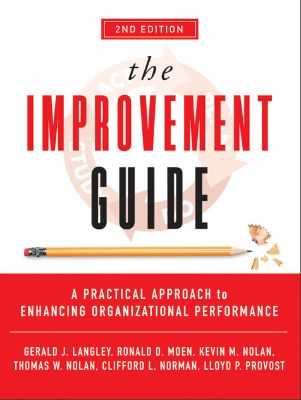The Improvement Guide: A Practical Approach to Enhancing Organizational Performance

Lýsing:
The most comprehensive source for the latest research and practice techniques for diagnosing and treating addictive disorders "This book brings together an array of international experts on addictive disorders. Robert Coombs's Handbook of Addictive Disorders discusses the contemporary issues surrounding the understanding of addiction, from diagnosis to treatment of an addicted client. The Handbook of Addictive Disorders is an example of practical and clinical information at its best.
" -Lorraine D. Grymala, Executive Director American Academy of Health Care Providers in the Addictive Disorders The Handbook of Addictive Disorders: A Practical Guide to Diagnosis and Treatment is a comprehensive, state-of-the-art resource, featuring valuable contributions from a multidisciplinary team of leading experts. This unique guide deftly defines addiction and examines its comorbidity with other problems.
Subsequent chapters present an overview of addictive disorders coupled with strategies for accurately diagnosing them, planning effective treatment, and selecting appropriate interventions. Chapters on public policy and prevention are of indispensable value in light of this growing health concern. The only reference available to cover the full spectrum of addictions and addictive behaviors, the Handbook of Addictive Disorders provides the most current research and treatment strategies for overcoming: Chemical dependency Workaholism Compulsive gambling Eating disorders Sex addiction Compulsive buying This useful guide features case studies, figures and diagrams, lists of practical interventions for each disorder, and self-assessment exercises for clients.
Annað
- Höfundur: Gerald J. Langley, Ronald Moen, Kevin M. Nolan, Thomas W. Nolan, Clifford L. Norman, Lloyd P. Provos
- Útgáfa:2
- Útgáfudagur: 2009-06-03
- Hægt að prenta út 10 bls.
- Hægt að afrita 2 bls.
- Format:ePub
- ISBN 13: 9780470549032
- Print ISBN: 9780470192412
- ISBN 10: 0470549033
Efnisyfirlit
- Cover
- Title
- Copyright
- FOREWORD
- PREFACE
- ACKNOWLEDGMENTS
- THE AUTHORS
- INTRODUCTION: THE IMPROVEMENT GUIDE, SECOND EDITION
- Why Take the Initiative?
- How Is This Book Different?
- Structure of the Book
- How to Read the Book
- PART ONE: INTRODUCTION TO IMPROVEMENT
- CHAPTER ONE: CHANGES THAT RESULT IN IMPROVEMENT
- Principles of Improvement
- The Model for Improvement
- Key Points from Chapter One
- CHAPTER TWO: SKILLS TO SUPPORT IMPROVEMENT
- Supporting Change with Data
- Developing a Change
- Testing a Change
- Implementing a Change
- Spreading Improvements
- The Human Side of Change
- Key Points from Chapter Two
- CHAPTER THREE: IMPROVEMENT CASE STUDIES
- Case Study 1: Improving the Morning Meeting
- Case Study 2: Improving Service in a Dental Office
- Case Study 3: Improving Methods for Teaching Biology
- Case Study 4: Contamination in Shipping Drums
- Case Study 5: Reducing Energy Use in School
- Key Points from Chapter Three
- CHAPTER ONE: CHANGES THAT RESULT IN IMPROVEMENT
- CHAPTER FOUR: THE SCIENCE OF IMPROVEMENT
- Profound Knowledge
- Milestones in the Development of Profound Knowledge
- Key Points from Chapter Four
- CHAPTER FIVE: USING THE MODEL FOR IMPROVEMENT
- What Are We Trying to Accomplish?
- How Will We Know That a Change Is an Improvement?
- What Changes Can We Make That Will Result in Improvement?
- The Plan-Do-Study-Act Cycle
- Using the Cycle to Build Knowledge
- Key Points from Chapter Five
- CHAPTER SIX: DEVELOPING A CHANGE
- Some Typical Problems in Developing Changes
- Reactive Versus Fundamental Change
- Theory for Change
- Methods for Developing Fundamental Change
- Key Points from Chapter Six
- CHAPTER SEVEN: TESTING A CHANGE
- Applying the Science of Improvement to Testing
- Principles for Testing a Change
- Designs for Testing a Change
- Strategies for Testing
- Key Points from Chapter Seven
- CHAPTER EIGHT: IMPLEMENTING A CHANGE
- Testing a Change
- Implementing a Change
- Implementation as a Series of Cycles
- Implementing Changes to Achieve and Maintain Improvement
- The Social Aspects of Implementing a Change
- Key Points from Chapter Eight
- CHAPTER NINE: SPREADING IMPROVEMENTS
- A Framework for Spread
- Phase for Organizational Readiness for Spread
- Phase for Developing an Initial Spread Plan
- Phase for Executing and Refining the Spread Plan
- Key Points from Chapter Nine
- CHAPTER TEN: INTEGRATING METHODS FOR THE IMPROVEMENT OF VALUE
- Eliminating Quality Problems
- Reducing Costs While Maintaining or Improving Quality
- Expanding the Expectations of Customers to Increase Demand
- Developing an Environment Conducive to the Improvement of Value
- Key Points from Chapter Ten
- CHAPTER ELEVEN: IMPROVING LARGE OR COMPLEX SYSTEMS
- Project Setup and Management
- Understanding the System and Developing High-Impact Changes
- Testing and Learning Systems
- Key Points from Chapter Eleven
- CHAPTER TWELVE: CASE STUDIES OF IMPROVEMENT EFFORTS
- Case Study 1: Reducing the Occurrence of No-Fault-Found Components
- Case Study 2: Improving the Drill Process
- Case Study 3: Reducing Infection and Mortality Rates in a Pediatric Intensive Care Unit
- Case Study 4: Improving Safety at a Manufacturing Plant
- Progressive Discipline System
- Other Areas of Improvement
- Summary of Results
- Case Study 5: Improving the Credentialing Process at CareOregon
- Case Study 6: Improving Sales at a Specialty Chemical Company
- Key Points from Chapter Twelve
- CHAPTER THIRTEEN: MAKING THE IMPROVEMENT OF VALUE A BUSINESS STRATEGY
- Building the System of Improvement
- Key Points from Chapter Thirteen
- CHAPTER FOURTEEN: DEVELOPING IMPROVEMENT CAPABILITY
- Developing Improvement Capability in the Workforce
- Organization to Support the Focus on Improvement
- Development of Other Capabilities
- Key Points from Chapter Fourteen
- Sample Agendas for Getting Started, Sponsors, and Improvement Advisors
- Development of Internal Improvement Advisors: Topical Agenda
- APPENDIX A: A RESOURCE GUIDE TO CHANGE CONCEPTS
- How to Use Change Concepts
- The Change Concepts
- APPENDIX B: TOOLS AND METHODS TO SUPPORT IMPROVEMENT
- Methods and Tools for Viewing Systems and Processes
- Methods and Tools for Gathering Information
- Methods and Tools for Organizing Information
- Methods and Tools for Understanding Variation
- Methods and Tools for Understanding Relationships
- Methods and Tools for Project Management
- Standard Forms for Improvement Projects
- APPENDIX C: THE MODEL FOR IMPROVEMENT AND OTHER ROADMAPS
- Fundamental Questions for Improvement
- Alternative Roadmaps for Improvement Projects
- Summary
UM RAFBÆKUR Á HEIMKAUP.IS
Bókahillan þín er þitt svæði og þar eru bækurnar þínar geymdar. Þú kemst í bókahilluna þína hvar og hvenær sem er í tölvu eða snjalltæki. Einfalt og þægilegt!Rafbók til eignar
Rafbók til eignar þarf að hlaða niður á þau tæki sem þú vilt nota innan eins árs frá því bókin er keypt.
Þú kemst í bækurnar hvar sem er
Þú getur nálgast allar raf(skóla)bækurnar þínar á einu augabragði, hvar og hvenær sem er í bókahillunni þinni. Engin taska, enginn kyndill og ekkert vesen (hvað þá yfirvigt).
Auðvelt að fletta og leita
Þú getur flakkað milli síðna og kafla eins og þér hentar best og farið beint í ákveðna kafla úr efnisyfirlitinu. Í leitinni finnur þú orð, kafla eða síður í einum smelli.
Glósur og yfirstrikanir
Þú getur auðkennt textabrot með mismunandi litum og skrifað glósur að vild í rafbókina. Þú getur jafnvel séð glósur og yfirstrikanir hjá bekkjarsystkinum og kennara ef þeir leyfa það. Allt á einum stað.
Hvað viltu sjá? / Þú ræður hvernig síðan lítur út
Þú lagar síðuna að þínum þörfum. Stækkaðu eða minnkaðu myndir og texta með multi-level zoom til að sjá síðuna eins og þér hentar best í þínu námi.
Fleiri góðir kostir
- Þú getur prentað síður úr bókinni (innan þeirra marka sem útgefandinn setur)
- Möguleiki á tengingu við annað stafrænt og gagnvirkt efni, svo sem myndbönd eða spurningar úr efninu
- Auðvelt að afrita og líma efni/texta fyrir t.d. heimaverkefni eða ritgerðir
- Styður tækni sem hjálpar nemendum með sjón- eða heyrnarskerðingu
- Gerð : 208
- Höfundur : 12455
- Útgáfuár : 2009
- Leyfi : 379


